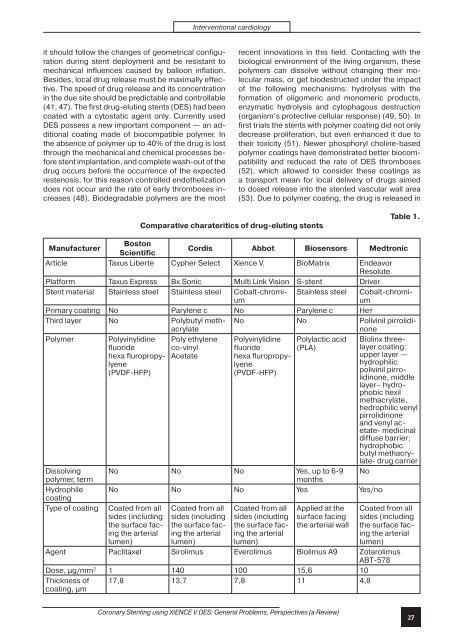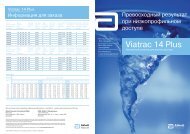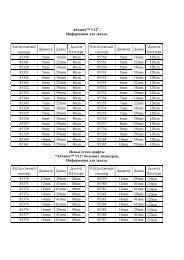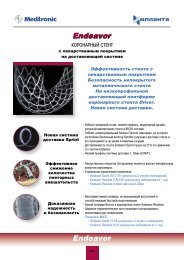Results of Coronary Stenting using the Stents with
Results of Coronary Stenting using the Stents with
Results of Coronary Stenting using the Stents with
You also want an ePaper? Increase the reach of your titles
YUMPU automatically turns print PDFs into web optimized ePapers that Google loves.
Interventional cardiology<br />
it should follow <strong>the</strong> changes <strong>of</strong> geometrical configuration<br />
during stent deployment and be resistant to<br />
mechanical influences caused by balloon inflation.<br />
Besides, local drug release must be maximally effective.<br />
The speed <strong>of</strong> drug release and its concentration<br />
in <strong>the</strong> due site should be predictable and controllable<br />
(41, 47). The first drug-eluting stents (DES) had been<br />
coated <strong>with</strong> a cytostatic agent only. Currently used<br />
DES possess a new important component — an additional<br />
coating made <strong>of</strong> biocompatible polymer. In<br />
<strong>the</strong> absence <strong>of</strong> polymer up to 40% <strong>of</strong> <strong>the</strong> drug is lost<br />
through <strong>the</strong> mechanical and chemical processes before<br />
stent implantation, and complete wash-out <strong>of</strong> <strong>the</strong><br />
drug occurs before <strong>the</strong> occurrence <strong>of</strong> <strong>the</strong> expected<br />
restenosis; for this reason controlled endo<strong>the</strong>lization<br />
does not occur and <strong>the</strong> rate <strong>of</strong> early thromboses increases<br />
(48). Biodegradable polymers are <strong>the</strong> most<br />
recent innovations in this field. Contacting <strong>with</strong> <strong>the</strong><br />
biological environment <strong>of</strong> <strong>the</strong> living organism, <strong>the</strong>se<br />
polymers can dissolve <strong>with</strong>out changing <strong>the</strong>ir molecular<br />
mass, or get biodestructed under <strong>the</strong> impact<br />
<strong>of</strong> <strong>the</strong> following mechanisms: hydrolysis <strong>with</strong> <strong>the</strong><br />
formation <strong>of</strong> oligomeric and monomeric products,<br />
enzymatic hydrolysis and cytophagous destruction<br />
(organism’s protective cellular response) (49, 50). In<br />
first trials <strong>the</strong> stents <strong>with</strong> polymer coating did not only<br />
decrease proliferation, but even enhanced it due to<br />
<strong>the</strong>ir toxicity (51). Newer phosphoryl choline-based<br />
polymer coatings have demonstrated better biocompatibility<br />
and reduced <strong>the</strong> rate <strong>of</strong> DES thromboses<br />
(52), which allowed to consider <strong>the</strong>se coatings as<br />
a transport mean for local delivery <strong>of</strong> drugs aimed<br />
to dosed release into <strong>the</strong> stented vascular wall area<br />
(53). Due to polymer coating, <strong>the</strong> drug is released in<br />
Comparative charateritics <strong>of</strong> drug-eluting stents<br />
Table 1.<br />
Manufacturer<br />
Boston<br />
Scientific<br />
Cordis Abbot Biosensors Medtronic<br />
Article Taxus Liberte Cypher Select Xience V. BioMatrix Endeavor<br />
Resolute<br />
Platform Taxus Express Bx Sonic Multi Link Vision S-stent Driver<br />
Stent material Stainless steel Stainless steel Cobalt-chromium<br />
Stainless steel Cobalt-chromium<br />
Primary coating No Parylene c No Parylene c Нет<br />
Third layer No Polybutyl methacrylate<br />
No No Polivinil pirrolidinone<br />
Polymer Polyvinylidine Poly ethylene Polyvinylidine Polylactic acid Biolinx threelayer<br />
coating:<br />
fluoride<br />
co-vinyl<br />
fluoride<br />
(PLA)<br />
hexa fluropropylyenlyene<br />
hydrophilic<br />
Acetate<br />
hexa fluropropy-<br />
upper layer —<br />
(PVDF-HFP)<br />
(PVDF-HFP)<br />
polivinil pirrolidinone,<br />
middle<br />
layer– hydrophobic<br />
hexil<br />
methacrylate,<br />
hedrophilic venyl<br />
pirrolidinone<br />
and venyl acetate-<br />
medicinal<br />
diffuse barrier;<br />
hydrophobic<br />
butyl methacrylate-<br />
drug carrier<br />
Dissolving No No No Yes, up to 6-9 No<br />
polymer, term<br />
months<br />
Hydrophile<br />
coating<br />
No No No Yes Yes/no<br />
Type <strong>of</strong> coating<br />
Coated from all<br />
sides (including<br />
<strong>the</strong> surface facing<br />
<strong>the</strong> arterial<br />
lumen)<br />
Coated from all<br />
sides (including<br />
<strong>the</strong> surface facing<br />
<strong>the</strong> arterial<br />
lumen)<br />
Coated from all<br />
sides (including<br />
<strong>the</strong> surface facing<br />
<strong>the</strong> arterial<br />
lumen)<br />
Applied at <strong>the</strong><br />
surface facing<br />
<strong>the</strong> arterial wall<br />
Coated from all<br />
sides (including<br />
<strong>the</strong> surface facing<br />
<strong>the</strong> arterial<br />
lumen)<br />
Agent Paclitaxel Sirolimus Everolimus Biolimus A9 Zotarolimus<br />
ABT-578<br />
Dose, μg/mm 2 1 140 100 15,6 10<br />
Thickness <strong>of</strong><br />
coating, μm<br />
17,8 13,7 7,8 11 4,8<br />
<strong>Coronary</strong> <strong>Stenting</strong> <strong>using</strong> XIENCE V DES: General Problems, Perspectives (a Review)<br />
27
















